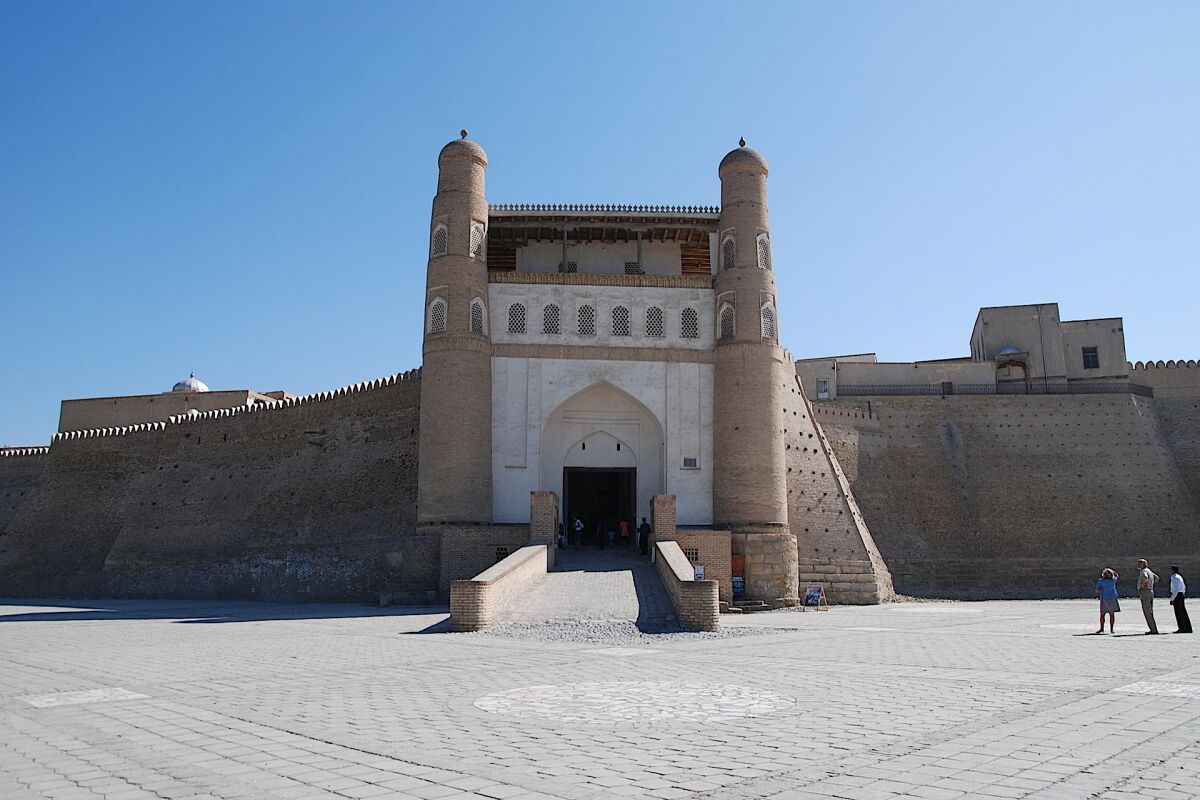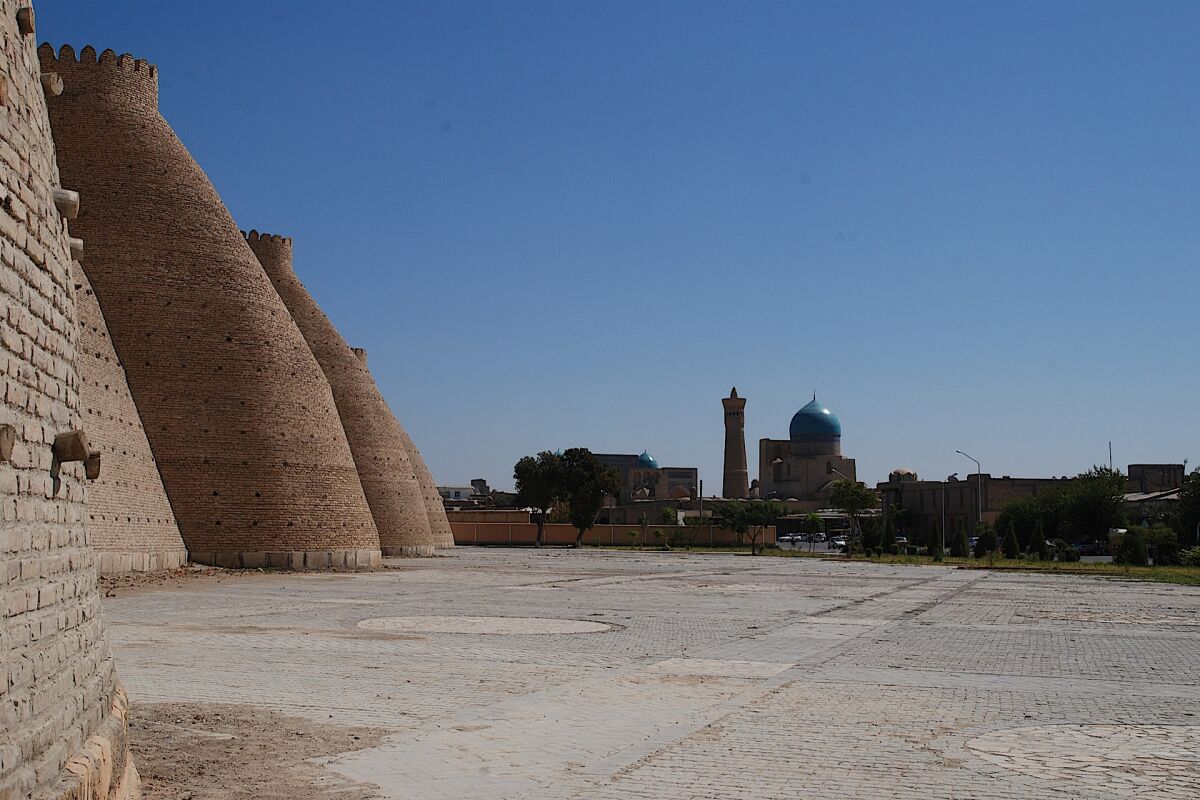Bukhara - Citadel Ark
In the centre of Bukhara there is a bulwark of the last emirs – the citadel Ark. The archaeological remains of the beginning of our era, when several settlements already existed on Bukhara, are much deeper than its present location.
High brick walls with a serrated end hide a huge hill – this is where the city of Bukhara appeared in ancient times, more than two thousand years ago. This is its fortress, the Ark Citadel.

Over the centuries its height gradually increased as new buildings were erected in place of dilapidated ones. According to legend, the tomb of Siyavush, the legendary founder of the city, was located here.
Queen Hutak Khatun lived and reigned here in the 7th century A.D. She defended Bukhara from the Arabs for several years with cunning and diplomacy. The medieval historian Narshakhi wrote about these events: “Allah instilled fear in the hearts of the infidels and they left without accepting the fight”.
Remains of former forts and palaces are hidden in the archaeological deposits of Ark. In the later Middle Ages Bukhara emirs lived here. Next to the gate there was a whip (“Kamchin”) as an impressive reminder of the emir’s power.
Only a few buildings of the former mighty Ark have survived. On the upper terrace of Nagorakhan flour was collected around the clock. Trophy clocks – chimes (made in the XIX century by the captured Italian Orlando) rang every hour on the bell tower and five times a day appeared on the tower of Azanchi (the person calling for prayer), announcing the beginning of the prayer.
During Ramazan or Kurban and other festive events, an orchestra played with four unique changes of curtain and dress of the musicians: light, yellow, fire red and black.
The square in front of the entrance to the citadel Ark – Registan, was the main arena of all events in the city and the religious centre of Bukhara. The Ark Citadel is the result of the efforts of thousands of slaves who many centuries ago, under the bright sun, created an artificial hill by hand and without equipment.
In order to present the scale of this gigantic work, we, the people of our era, must forget modern technology and exclude even such means of transport as Arava. This mighty fortress rises above Registan Square as a symbol of greatness, power and insurmountability.
This is the goal pursued by those in power. And yet the impression was deceptive. For a very long time, the citadel has not held Ark steadfast. Repeatedly it has been built and destroyed.
The age of the Ark Citadel is not exactly determined, but at least one and a half thousand years ago, this majestic fortress was already the seat of the ruler of a vast and densely populated country.
For many centuries Ark remained the main residence of the Emir of Bukhara, the place from which the supreme command of the country was exercised. Here, in a mighty fortified citadel, lived not only the emir but also the chief vizier, the military leaders, the emir’s most numerous servants.
The Ark Citadel is a living witness to the rich history of the city. When Genghis Khan’s warriors conquered Bukhara in 1220, the city’s inhabitants locked themselves in the Ark and Genghis Khan’s warriors invaded the Ark, killing the defenders, plundering values and destroying the fortress.
Repeatedly, riots broke out in the city and then Ark became the epitome of cruel tyranny, cobblestones flew outside its gates, as they did in 1708 during the uprising associated with the abolition of currency reform.
Here in Ark Citadel, apart from the rulers cursed by the people, great scientists, poets and philosophers lived and worked. In the Middle Ages, when the culture of Bukhara reached its peak, Rudaki, Firdousi, Abu Ali ibn Sina, Farabi and later Omar Khayyam worked here.
Ark is a large above ground complex. From the ground plan it resembles an irregular rectangle, which extends slightly from west to east. Its southeast corner is slightly cut.
It is located in the middle of the western part of the modern city. The length of the walls is 789.60 m, the area is 3.96 ha. The height from the level of Registan Square, in the vicinity of which it is located, varies between 16 and 20 metres.
The front entrance to the Citadel Ark is architecturally designed in the form of two pier towers. The upper part of the tower is connected to the gallery, above which there is a room with terraces.
The entrance to the gate (tahkul) is a ramp or gradually ascending path that leads through a long covered corridor to the Jami Mosque. The ramp is fenced in on both sides with a massive stone railing, its length is about 20 metres.
On one of the walls of the Ark Citadel there was a large leather whip (a symbol of the emir’s power). A long dark corridor starts from the gate of the Citadel Ark, along which are the rooms for water and sand, the cells for prisoners.

It is known from historical materials and from the accounts of eyewitnesses what sophisticated tortures the emir used to subjugate his subjects. In the citadel Ark itself there is a large complex of buildings.
The eastern half of the arch is now an archaeological monument. The Childukhtaron Mosque, with which the legend of forty tortured girls thrown into the well is connected, has been preserved here.
From the height of the Ark Citadel there is a breathtakingly unique panorama of the ancient part of Bukhara. The restorers in Bukhara call the Bukhara Citadel Ark a textbook for builders. Extensive restoration work is currently underway in the Citadel Ark.
The walls on the side of Registan Square and many rooms inside the citadel have been restored.
